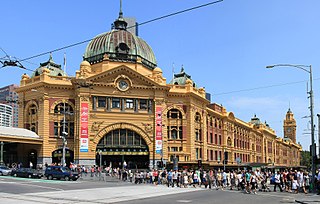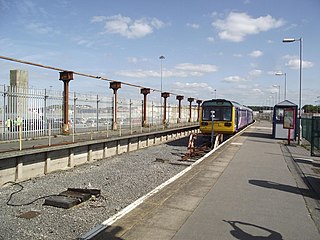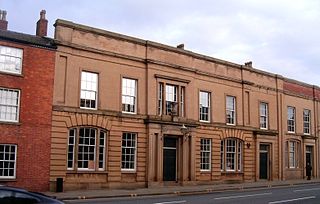
Battersea is a large district of South West London, England and in the London Borough of Wandsworth. It is centred 3.5 miles (5.6 km) southwest of Charing Cross and extends along a curve that includes a west bank, on the south bank of London's reaches of the Thames. It includes Battersea Park, a 200-acre (0.81 km2) northern rectangle by the Thames.

Battersea Power Station is a decommissioned coal-fired power station, located on the south bank of the River Thames, in Nine Elms, Battersea, in the London Borough of Wandsworth. It was built by the London Power Company (LPC) to the design of Leonard Pearce, Engineer in Chief to the LPC, and CS Allott & Son Engineers. The architects were J Theo Halliday and Giles Gilbert Scott. The station is one of the world's largest brick buildings and notable for its original, Art Deco interior fittings and decor.

NI Railways, also known as Northern Ireland Railways (NIR) and for a brief period Ulster Transport Railways (UTR), is the railway operator in Northern Ireland. NIR is a subsidiary of Translink, whose parent company is the Northern Ireland Transport Holding Company (NITHCo), and is one of five publicly-owned train operators in the United Kingdom, the others being Direct Rail Services, Northern Trains, Transport for Wales Rail and LNER. It has a common Board of Management with the other two companies in the group, Ulsterbus and Metro.

Victoria station, also known as London Victoria, is a central London railway terminus and connected London Underground station in Victoria, in the City of Westminster, managed by Network Rail. Named after the nearby Victoria Street, the main line station is a terminus of the Brighton main line to Gatwick Airport and Brighton and the Chatham main line to Ramsgate and Dover via Chatham. From the main lines, trains can connect to the Catford Loop Line, Dartford Loop Line, and the Oxted line to East Grinstead and Uckfield. Southern operates most commuter and regional services to south London, Sussex and parts of east Surrey, while Southeastern operates trains to south east London and Kent. Gatwick Express trains run direct to Gatwick. The Underground station is on the Circle and District lines between Sloane Square and St. James's Park, and the Victoria line between Pimlico and Green Park. The area around the station is an important interchange for other forms of transport: a local bus station is in the forecourt and Victoria Coach Station is nearby.

Battersea Park is a suburban railway station in the London Borough of Wandsworth, south London. It is at the junction of the South London Line and the Brighton Main Line, 1 mile 23 chains (2.1 km) measured from London Victoria.

The Southern Railway (SR), sometimes shortened to 'Southern', was a British railway company established in the 1923 Grouping. It linked London with the Channel ports, South West England, South coast resorts and Kent. The railway was formed by the amalgamation of several smaller railway companies, the largest of which were the London & South Western Railway (LSWR), the London, Brighton and South Coast Railway (LB&SCR) and the South Eastern and Chatham Railway (SE&CR). The construction of what was to become the Southern Railway began in 1838 with the opening of the London and Southampton Railway, which was renamed the London & South Western Railway.

Rail transport in Ireland is provided by Iarnród Éireann in the Republic of Ireland and by Northern Ireland Railways in Northern Ireland.

The Melbourne rail network is a passenger and freight train system in the city of Melbourne, Victoria, Australia. It is the core of the larger Victorian railway network, with links to both intrastate and interstate systems. A large suburban passenger network centred on the CBD also operates, with a limited degree of segregation from longer-distance passenger and freight trains.

The British Rail Class 488 are unpowered trailer sets, converted from Mark 2F coaches for the Gatwick Express service from London Victoria railway station to Gatwick Airport.

The British Rail Class 423, or 4 VEP, electric multiple-unit passenger trains were mostly built by British Rail (BR) at York Works from 1967 to 1974, although the MBSOs and TSOs of the first 20, 7701-7720, were built at Derby Works. They feature manually opening doors next to every seating row and were the last coaching stock built in this pattern for BR. They were mostly found working outer-suburban services in South London and rural services in Kent, Sussex and Hampshire, up to 2005 when they were finally replaced by Electrostar and Desiro units. The fleet had a working life of 38 years.

Heysham Port is a railway station on the Morecambe Branch Line, which runs between Lancaster and Heysham Port. The station, situated 7+3⁄4 miles (12 km) west of Lancaster, serves Heysham Port in Lancashire. It is owned by Network Rail and managed by Northern Trains.

The Comeng is a type of electric train that operates on the suburban railway network of Melbourne, Australia. They were introduced in 1981 by VicRail to replace the last of the 60-year-old Tait trains. More were ordered after the failed refurbishment and subsequent withdrawal of the Harris trains. In total 570 carriages were built by Comeng, Dandenong.

The Glenbrook Vintage Railway (GVR) is a heritage steam railway in Glenbrook, New Zealand.
The Sheffield District Rail Rationalisation Plan was a series of linked railway civil engineering projects, station and line closures and train route changes that took place in and around Sheffield, South Yorkshire. The majority of these changes took place in the 1960s and early 1970s, however the plan, by now much modified in the face of rapidly dwindling freight traffic, was not fully realised until the 1980s.

Liverpool Road is a former railway station on the Liverpool and Manchester Railway in Manchester, England that opened on 15 September 1830. The station was the Manchester terminus of the world's first inter-city passenger railway in which all services were hauled by timetabled steam locomotives. It is the world's oldest surviving terminal railway station.

The Tait trains were a wooden bodied Electric Multiple Unit train that operated on the suburban railway network of Melbourne, Victoria, Australia. They were introduced in 1910 by the Victorian Railways as steam locomotive hauled cars, and converted to electric traction from 1919 when the Melbourne electrification project was underway. The trains derived their name from Sir Thomas James Tait, the chairman of commissioners of the Victorian Railways from 1903 to 1910. The first cars were built during 1909 with the last entering service in 1952.

The H type carriages are an Australian interurban passenger carriage operated by V/Line. Fitted with high-density 2+3 seating, they are typically used on short distance interurban services from Melbourne to Bacchus Marsh, Seymour and Wyndham Vale.

The New Deal for Country Passengers was a timetable introduced on 4 October 1981 in Victoria, Australia which revolutionised the provision of country passenger railway services. Thirty-five little-used passenger stations were closed, rolling stock utilisation was improved, and new rolling stock introduced. The timetable and associated service changes resulted in an average patronage growth of 8.7% per year, from 3 million in 1981 to 5.6 million passengers in 1990/91.

The Northern line extension to Battersea is an extension of the London Underground Northern line currently under construction from Kennington to Battersea in South West London, terminating at the redeveloped Battersea Power Station. The extension will form a continuation of the Charing Cross branch of the line.

Stewarts Lane is a large railway-servicing facility in Battersea in London, England, founded by the London Chatham and Dover Railway (LCDR) in 1862, to serve London Victoria railway station. It is sited in the midst of a maze of railway lines between 'Factory Junction' and 'Stewarts Lane Junction', adjacent to the site of the former Longhedge Railway Works. Prior to 1962 it was one of the largest motive power depots in the UK. Following the end of steam traction in the early 1960s it was converted into a Traction Maintenance Depot which is currently operated by Govia Thameslink Railway.



















